tyre pressure FIAT MULTIPLA 2006 1.G Owners Manual
[x] Cancel search | Manufacturer: FIAT, Model Year: 2006, Model line: MULTIPLA, Model: FIAT MULTIPLA 2006 1.GPages: 266, PDF Size: 4.61 MB
Page 144 of 266

143
WARNING
LIGHTS AND
MESSAGES
IN AN
EMERGENCY
CAR
MAINTENANCE
TECHNICAL
SPECIFICATIONS
INDEX
DASHBOARD
AND CONTROLS
SAFETY
DEVICES
CORRECT USE
OF THE CAR
CONTAINING RUNNING COSTS
Here are some suggestions which may help you to
keep the running costs of your car down and lower
the amount of toxic emissions released into the
atmosphere.
GENERAL CONSIDERATIONS
Car maintenance
Have checks and adjustments carried out in
accordance with the “Service schedule”.
Tyres
Check the pressure of the tyres routinely at an
interval of no more than 4 weeks: if the pressure is
too low, consumption levels increase as resistance to
rolling is higher.
Unnecessary loads
Do not travel with too much luggage stowed in the
boot. The weight of the car (especially when driving in
town) and its trim greatly affects consumption and
stability.Roof rack/ski rack
Remove the roof rack or the ski rack from the roof as
soon as they are no longer used. These accessories
lower air penetration and adversely affect
consumption levels. When needing to carry
particularly voluminous objects, preferably use a
trailer.
Electric devices
Use electric devices only for the amount of time
needed. Rear heated window, additional headlights,
windscreen wipers and heater fan need a considerable
amount of energy, therefore increasing the
requirement of current increases fuel consumption (up
to +25% in the urban cycle).
Climate control
The air conditioner is an additional load which greatly
affects the engine leading to higher consumption (on
average up to +20%). When the temperature outside
the vehicle permits it, use the air vents where possible.
Aerodynamic accessories
The use of non-certified aerodynamic items may
adversely affect air drag and consumption levels.
Page 150 of 266
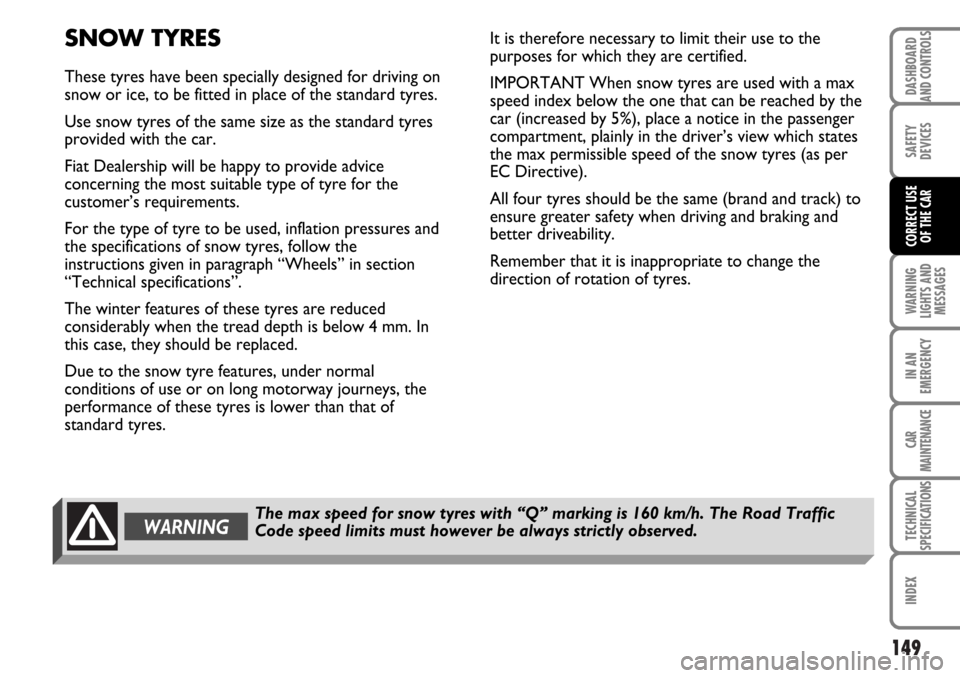
149
WARNING
LIGHTS AND
MESSAGES
IN AN
EMERGENCY
CAR
MAINTENANCE
TECHNICAL
SPECIFICATIONS
INDEX
DASHBOARD
AND CONTROLS
SAFETY
DEVICES
CORRECT USE
OF THE CAR
SNOW TYRES
These tyres have been specially designed for driving on
snow or ice, to be fitted in place of the standard tyres.
Use snow tyres of the same size as the standard tyres
provided with the car.
Fiat Dealership will be happy to provide advice
concerning the most suitable type of tyre for the
customer’s requirements.
For the type of tyre to be used, inflation pressures and
the specifications of snow tyres, follow the
instructions given in paragraph “Wheels” in section
“Technical specifications”.
The winter features of these tyres are reduced
considerably when the tread depth is below 4 mm. In
this case, they should be replaced.
Due to the snow tyre features, under normal
conditions of use or on long motorway journeys, the
performance of these tyres is lower than that of
standard tyres.It is therefore necessary to limit their use to the
purposes for which they are certified.
IMPORTANT When snow tyres are used with a max
speed index below the one that can be reached by the
car (increased by 5%), place a notice in the passenger
compartment, plainly in the driver’s view which states
the max permissible speed of the snow tyres (as per
EC Directive).
All four tyres should be the same (brand and track) to
ensure greater safety when driving and braking and
better driveability.
Remember that it is inappropriate to change the
direction of rotation of tyres.
The max speed for snow tyres with “Q” marking is 160 km/h. The Road Traffic
Code speed limits must however be always strictly observed.WARNING
Page 152 of 266

151
WARNING
LIGHTS AND
MESSAGES
IN AN
EMERGENCY
CAR
MAINTENANCE
TECHNICAL
SPECIFICATIONS
INDEX
DASHBOARD
AND CONTROLS
SAFETY
DEVICES
CORRECT USE
OF THE CAR
STORING THE CAR
If the car is to be left inactive for longer than a month,
the following precautions should be noted:
❒Park the car in covered, dry and if possible well-
ventilated premises.
❒Engage a gear.
❒Check that the handbrake is not engaged.
❒Disconnect battery terminals (first disconnect the
negative terminal) and check the battery charge.
This check is to be repeated every month, recharge
if battery charge falls below 12.5V.
IMPORTANT Where relevant, switch off the
electronic car alarm with the remote control.❒Clean and protect the painted parts using protective
wax.
❒Clean and protect the shiny metal parts using special
compounds readily available.
❒Sprinkle talcum powder on the rubber windscreen
and rear window wiper blades and lift them off the
glass.
❒Slightly open the windows.
❒Cover the car with a cloth or perforated plastic
sheet. Do not use sheets of non-perforated plastic
as they do not allow moisture on the car body to
evaporate.
❒Inflate tyres to +0.5 bar above the normal specified
pressure and check it at intervals.
❒Do not drain the engine cooling system.
Page 170 of 266

169
SAFETY
DEVICES
CORRECT USE
OF THE CAR
WARNING
LIGHTS AND
MESSAGES
CAR
MAINTENANCE
TECHNICAL
SPECIFICATIONS
INDEX
DASHBOARD
AND CONTROLS
IN AN
EMERGENCY
WARNINGThe jack shall only be used for changing wheels on the car with which it is provided
or on cars of the same model. It must not be used for other purposes such as for
instance raising cars of other models. In no case should it be used for repairs under
the car. Incorrect positioning of the jack may cause the jacked vehicle to fall. Do
not use the jack for higher capacities than stated on its label. Snow chains cannot
be fitted to the space-saver spare wheel. So, if a front (drive) wheel is punctured
and chains are needed, a rear wheel should be fitted to the front of the vehicle and
the spare wheel should be fitted to the rear. This way with two normal drive
wheels, snow chains can be fitted to them to solve an emergency.
ATTENZIONEFasten the wheel cap correctly to prevent the wheel from coming free in motion.
Never tamper with the inflation valve. Never place tools between the rim and tyre.
Check and restore, if required, the pressure of tyres and spare wheel to the values
given in the “Technical specifications” section.
Page 177 of 266
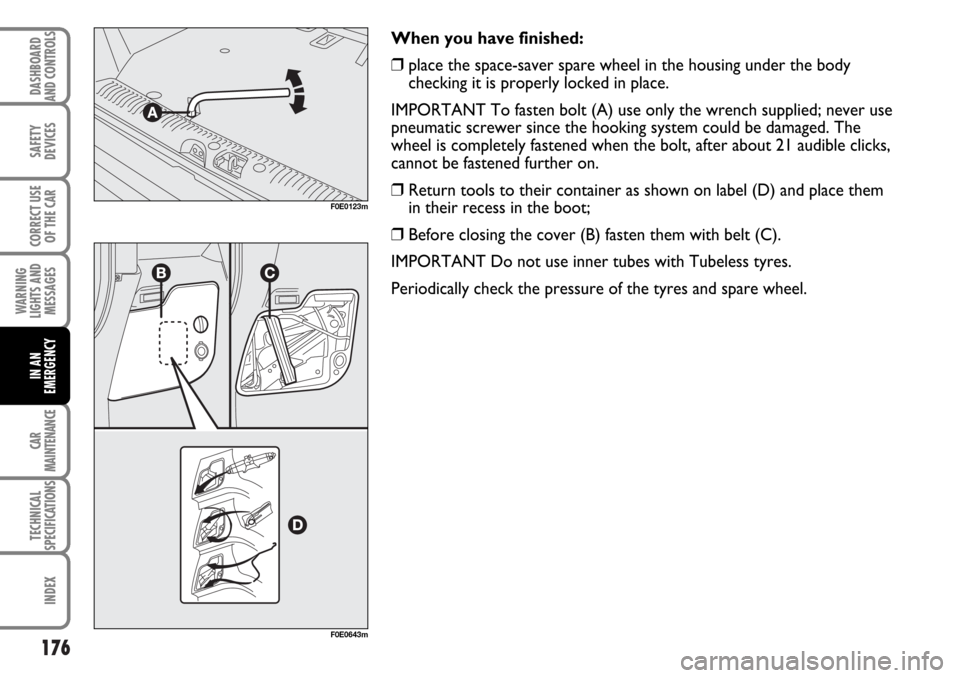
176
SAFETY
DEVICES
CORRECT USE
OF THE CAR
WARNING
LIGHTS AND
MESSAGES
CAR
MAINTENANCE
TECHNICAL
SPECIFICATIONS
INDEX
DASHBOARD
AND CONTROLS
IN AN
EMERGENCY
When you have finished:
❒place the space-saver spare wheel in the housing under the body
checking it is properly locked in place.
IMPORTANT To fasten bolt (A) use only the wrench supplied; never use
pneumatic screwer since the hooking system could be damaged. The
wheel is completely fastened when the bolt, after about 21 audible clicks,
cannot be fastened further on.
❒Return tools to their container as shown on label (D) and place them
in their recess in the boot;
❒Before closing the cover (B) fasten them with belt (C).
IMPORTANT Do not use inner tubes with Tubeless tyres.
Periodically check the pressure of the tyres and spare wheel.
F0E0123m
F0E0643m
Page 181 of 266
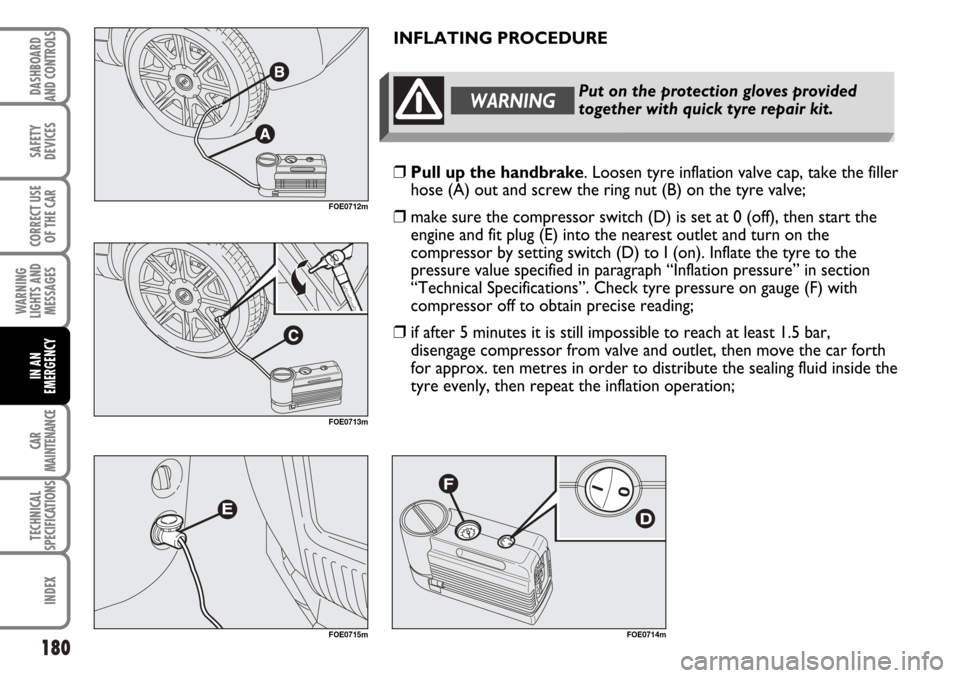
180
SAFETY
DEVICES
CORRECT USE
OF THE CAR
WARNING
LIGHTS AND
MESSAGES
CAR
MAINTENANCE
TECHNICAL
SPECIFICATIONS
INDEX
DASHBOARD
AND CONTROLS
IN AN
EMERGENCY
INFLATING PROCEDURE
FOE0712m
FOE0713m
FOE0715mFOE0714m
WARNINGPut on the protection gloves provided
together with quick tyre repair kit.
❒Pull up the handbrake. Loosen tyre inflation valve cap, take the filler
hose (A) out and screw the ring nut (B) on the tyre valve;
❒make sure the compressor switch (D) is set at 0 (off), then start the
engine and fit plug (E) into the nearest outlet and turn on the
compressor by setting switch (D) to I (on). Inflate the tyre to the
pressure value specified in paragraph “Inflation pressure” in section
“Technical Specifications”. Check tyre pressure on gauge (F) with
compressor off to obtain precise reading;
❒if after 5 minutes it is still impossible to reach at least 1.5 bar,
disengage compressor from valve and outlet, then move the car forth
for approx. ten metres in order to distribute the sealing fluid inside the
tyre evenly, then repeat the inflation operation;
Page 182 of 266
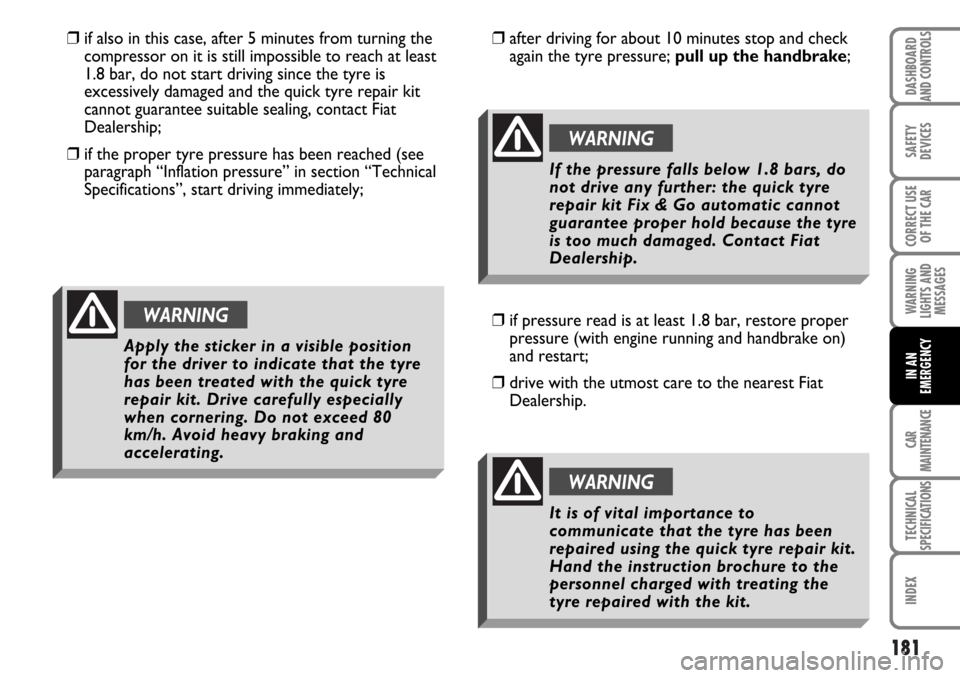
181
SAFETY
DEVICES
CORRECT USE
OF THE CAR
WARNING
LIGHTS AND
MESSAGES
CAR
MAINTENANCE
TECHNICAL
SPECIFICATIONS
INDEX
DASHBOARD
AND CONTROLS
IN AN
EMERGENCY
❒if also in this case, after 5 minutes from turning the
compressor on it is still impossible to reach at least
1.8 bar, do not start driving since the tyre is
excessively damaged and the quick tyre repair kit
cannot guarantee suitable sealing, contact Fiat
Dealership;
❒if the proper tyre pressure has been reached (see
paragraph “Inflation pressure” in section “Technical
Specifications”, start driving immediately;❒after driving for about 10 minutes stop and check
again the tyre pressure; pull up the handbrake;
WARNING
WARNING
WARNING
Apply the sticker in a visible position
for the driver to indicate that the tyre
has been treated with the quick tyre
repair kit. Drive carefully especially
when cornering. Do not exceed 80
km/h. Avoid heavy braking and
accelerating.
It is of vital importance to
communicate that the tyre has been
repaired using the quick tyre repair kit.
Hand the instruction brochure to the
personnel charged with treating the
tyre repaired with the kit. If the pressure falls below 1.8 bars, do
not drive any further: the quick tyre
repair kit Fix & Go automatic cannot
guarantee proper hold
because the tyre
is too much damaged.
Contact Fiat
Dealership.
❒if pressure read is at least 1.8 bar, restore proper
pressure (with engine running and handbrake on)
and restart;
❒drive with the utmost care to the nearest Fiat
Dealership.
Page 183 of 266

182
SAFETY
DEVICES
CORRECT USE
OF THE CAR
WARNING
LIGHTS AND
MESSAGES
CAR
MAINTENANCE
TECHNICAL
SPECIFICATIONS
INDEX
DASHBOARD
AND CONTROLS
IN AN
EMERGENCY
FOR CHECKING AND RESTORING PRESSURE ONLY
The compressor can be also used just for restoring pressure. Disconnect
the quick connection and connect it directly to the tyre valve; in this way
the cylinder is not connected to compressor and the sealing fluid will not
flow into the tyre.
CYLINDER REPLACEMENTPROCEDURE
To replace cylinder proceed as follows:
❒disconnect connection (A);
❒turn counter-clockwise the cylinder to replace and raise it;
❒fit the new cylinder and turn it clockwise;
❒connect connection (A) to the cylinder and fit the transparent tube (B)
into the proper space.
FOE0716m
FOE0721m
Page 207 of 266
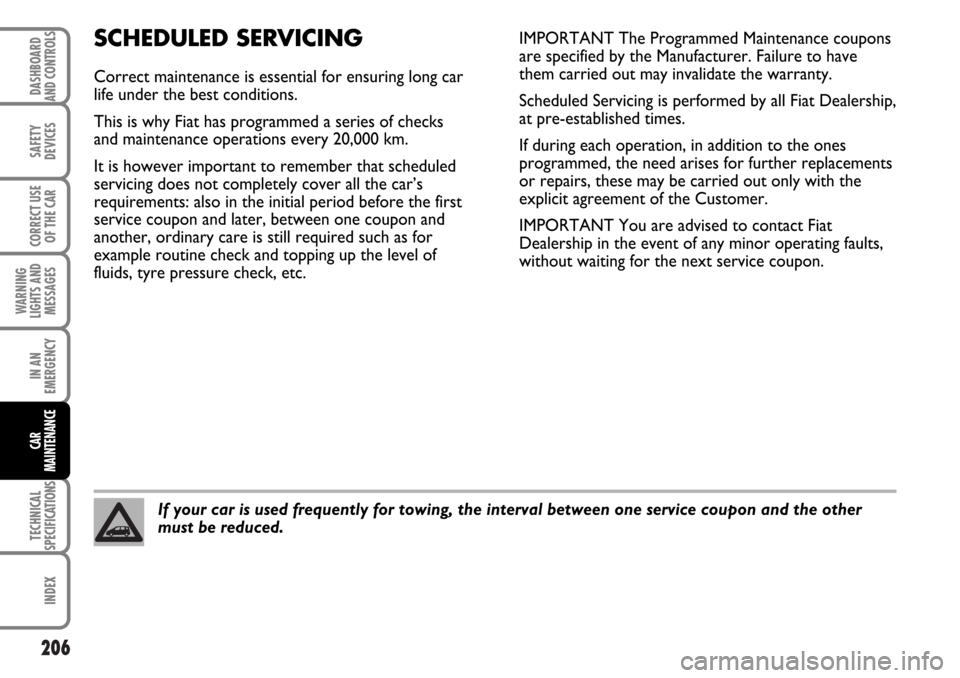
206
SAFETY
DEVICES
CORRECT USE
OF THE CAR
WARNING
LIGHTS AND
MESSAGES
IN AN
EMERGENCY
TECHNICAL
SPECIFICATIONS
INDEX
DASHBOARD
AND CONTROLS
CAR
MAINTENANCE
SCHEDULED SERVICING
Correct maintenance is essential for ensuring long car
life under the best conditions.
This is why Fiat has programmed a series of checks
and maintenance operations every 20,000 km.
It is however important to remember that scheduled
servicing does not completely cover all the car’s
requirements: also in the initial period before the first
service coupon and later, between one coupon and
another, ordinary care is still required such as for
example routine check and topping up the level of
fluids, tyre pressure check, etc.IMPORTANT The Programmed Maintenance coupons
are specified by the Manufacturer. Failure to have
them carried out may invalidate the warranty.
Scheduled Servicing is performed by all Fiat Dealership,
at pre-established times.
If during each operation, in addition to the ones
programmed, the need arises for further replacements
or repairs, these may be carried out only with the
explicit agreement of the Customer.
IMPORTANT You are advised to contact Fiat
Dealership in the event of any minor operating faults,
without waiting for the next service coupon.
If your car is used frequently for towing, the interval between one service coupon and the other
must be reduced.
Page 208 of 266
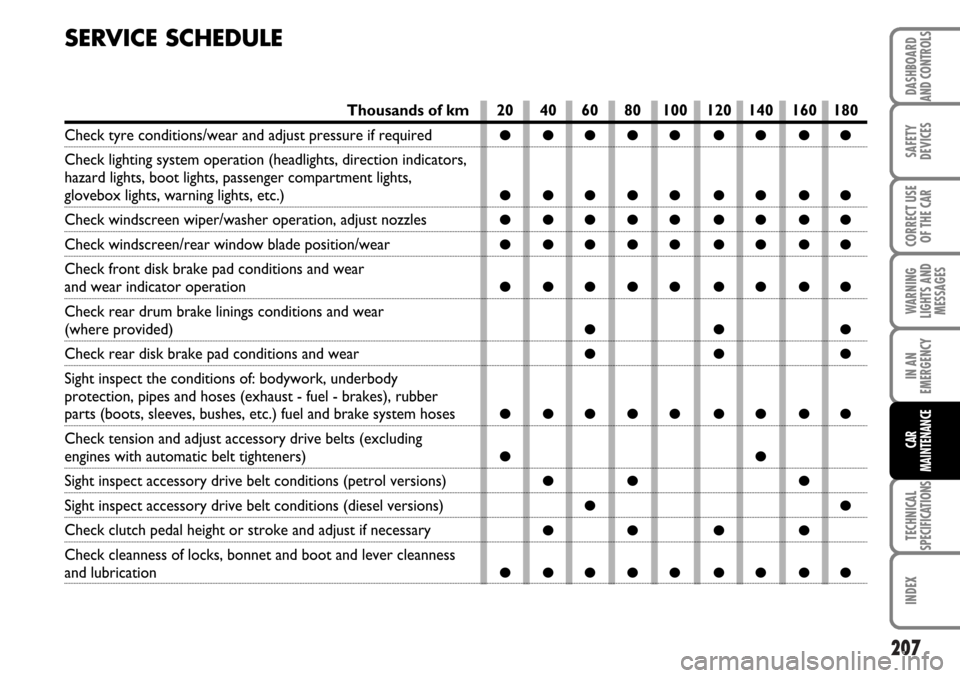
207
SAFETY
DEVICES
CORRECT USE
OF THE CAR
WARNING
LIGHTS AND
MESSAGES
TECHNICAL
SPECIFICATIONS
INDEX
DASHBOARD
AND CONTROLS
IN AN
EMERGENCY
CAR
MAINTENANCE
SERVICE SCHEDULE
20 40 60 80 100 120 140 160 180
●●●●● ●●●●
●●●●● ●●●●
●●●●● ●●●●
●●●●● ●●●●
●●●●● ●●●●
●●●
●●●
●●●●● ●●●●
●●
●● ●
●●
●● ● ●
●●●●● ●●●●
Thousands of km
Check tyre conditions/wear and adjust pressure if required
Check lighting system operation (headlights, direction indicators,
hazard lights, boot lights, passenger compartment lights,
glovebox lights, warning lights, etc.)
Check windscreen wiper/washer operation, adjust nozzles
Check windscreen/rear window blade position/wear
Check front disk brake pad conditions and wear
and wear indicator operation
Check rear drum brake linings conditions and wear
(where provided)
Check rear disk brake pad conditions and wear
Sight inspect the conditions of: bodywork, underbody
protection, pipes and hoses (exhaust - fuel - brakes), rubber
parts (boots, sleeves, bushes, etc.) fuel and brake system hoses
Check tension and adjust accessory drive belts (excluding
engines with automatic belt tighteners)
Sight inspect accessory drive belt conditions (petrol versions)
Sight inspect accessory drive belt conditions (diesel versions)
Check clutch pedal height or stroke and adjust if necessary
Check cleanness of locks, bonnet and boot and lever cleanness
and lubrication